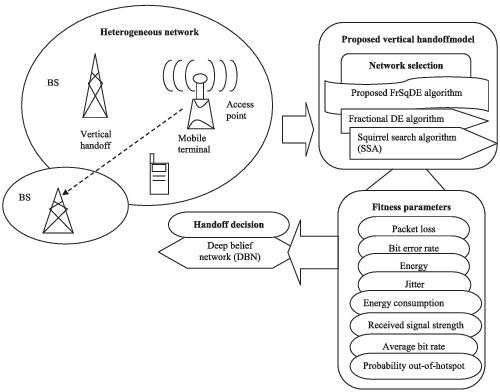当前位置:
X-MOL 学术
›
Int. J. Commun. Syst.
›
论文详情
Our official English website, www.x-mol.net, welcomes your
feedback! (Note: you will need to create a separate account there.)
Fractional squirrel–dolphin echolocation with deep belief network for network-controlled vertical handoff in disparate and heterogeneous wireless network
International Journal of Communication Systems ( IF 1.7 ) Pub Date : 2021-06-06 , DOI: 10.1002/dac.4893 Mithun B. Patil 1 , Rekha Patil 1
International Journal of Communication Systems ( IF 1.7 ) Pub Date : 2021-06-06 , DOI: 10.1002/dac.4893 Mithun B. Patil 1 , Rekha Patil 1
Affiliation

|
The innovative characteristics of different heterogeneous wireless networks provide better service. The disparate wireless access networks consist of wireless metropolitan access network (WMAN) and cellular networks. Various techniques are devised for dynamic network selection, but these techniques concentrated on attaining improved performance. To address this issue, a novel method is devised to improve the energy efficiency of disparate heterogeneous wireless networks. Here, the proposed fractional squirrel–dolphin echolocation (FrSqDE) algorithm is devised by integrating squirrel search optimization (SSA) and fractional dolphin echolocation (fractional DE) algorithm. In addition, the fitness function is considered with certain factors that include delay, bit error rate (BER), jitter, packet loss, energy consumption, probability of hot spot, average bit rate (ABR), and received signal strength (RSS). The proposed FrSqDE optimization algorithm is used for training deep belief networks (DBNs) to select optimal weights. Here, the network selection factors are given as input to the proposed FrSqDE-based DBN, wherein optimal decision is made to handle vertical handoff. The proposed FrSqDE-based DBN offered improved performance with a minimal call drop probability of 0.050, minimal delay of 0.013 s, minimal energy consumption of 0.393 J, and maximal throughput of 117.972 kbps.
中文翻译:

具有深度置信网络的分数松鼠海豚回声定位,用于异构和异构无线网络中的网络控制垂直切换
不同异构无线网络的创新特性提供更好的服务。不同的无线接入网络包括无线城域接入网络 (WMAN) 和蜂窝网络。为动态网络选择设计了各种技术,但这些技术集中在获得改进的性能上。为了解决这个问题,设计了一种新方法来提高不同异构无线网络的能量效率。在这里,提出的分数松鼠-海豚回声定位 (FrSqDE) 算法是通过集成松鼠搜索优化 (SSA) 和分数海豚回声定位 (分数 DE) 算法而设计的。此外,适应度函数还考虑了某些因素,包括延迟、误码率(BER)、抖动、丢包、能量消耗、热点概率、平均比特率 (ABR) 和接收信号强度 (RSS)。提出的 FrSqDE 优化算法用于训练深度信念网络 (DBN) 以选择最佳权重。在这里,网络选择因素作为所提出的基于 FrSqDE 的 DBN 的输入,其中做出最佳决策来处理垂直切换。提出的基于 FrSqDE 的 DBN 提供了改进的性能,最小掉话概率为 0.050,最小延迟为 0.013 s,最小能耗为 0.393 J,最大吞吐量为 117.972 kbps。其中做出最佳决策来处理垂直切换。提出的基于 FrSqDE 的 DBN 提供了改进的性能,最小掉话概率为 0.050,最小延迟为 0.013 s,最小能耗为 0.393 J,最大吞吐量为 117.972 kbps。其中做出最佳决策来处理垂直切换。提出的基于 FrSqDE 的 DBN 提供了改进的性能,最小掉话概率为 0.050,最小延迟为 0.013 s,最小能耗为 0.393 J,最大吞吐量为 117.972 kbps。
更新日期:2021-07-06
中文翻译:

具有深度置信网络的分数松鼠海豚回声定位,用于异构和异构无线网络中的网络控制垂直切换
不同异构无线网络的创新特性提供更好的服务。不同的无线接入网络包括无线城域接入网络 (WMAN) 和蜂窝网络。为动态网络选择设计了各种技术,但这些技术集中在获得改进的性能上。为了解决这个问题,设计了一种新方法来提高不同异构无线网络的能量效率。在这里,提出的分数松鼠-海豚回声定位 (FrSqDE) 算法是通过集成松鼠搜索优化 (SSA) 和分数海豚回声定位 (分数 DE) 算法而设计的。此外,适应度函数还考虑了某些因素,包括延迟、误码率(BER)、抖动、丢包、能量消耗、热点概率、平均比特率 (ABR) 和接收信号强度 (RSS)。提出的 FrSqDE 优化算法用于训练深度信念网络 (DBN) 以选择最佳权重。在这里,网络选择因素作为所提出的基于 FrSqDE 的 DBN 的输入,其中做出最佳决策来处理垂直切换。提出的基于 FrSqDE 的 DBN 提供了改进的性能,最小掉话概率为 0.050,最小延迟为 0.013 s,最小能耗为 0.393 J,最大吞吐量为 117.972 kbps。其中做出最佳决策来处理垂直切换。提出的基于 FrSqDE 的 DBN 提供了改进的性能,最小掉话概率为 0.050,最小延迟为 0.013 s,最小能耗为 0.393 J,最大吞吐量为 117.972 kbps。其中做出最佳决策来处理垂直切换。提出的基于 FrSqDE 的 DBN 提供了改进的性能,最小掉话概率为 0.050,最小延迟为 0.013 s,最小能耗为 0.393 J,最大吞吐量为 117.972 kbps。











































 京公网安备 11010802027423号
京公网安备 11010802027423号